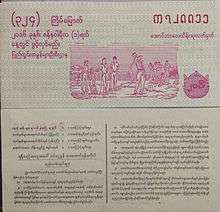Burmese lottery

Aungbalay (Burmese: အောင်ဘာလေထီ; also spelt Aung Bar Lay, lit. "may you win") is Myanmar's official state lottery. The monthly lottery is administered by the Ministry of Finance's State Lottery Department.[1][2] Lottery tickets are printed at a printing plant in Wazi, Magwe Region, at the same location where Burmese kyat notes and passports are printed.[3][4]
The first Burmese lottery was introduced during the Konbaung Dynasty. A national state lottery was first established in 1878 during the reign of King Thibaw Min, in an attempt to raise state revenues.[5] The lottery was the brainchild of Pho Hlaing, who had played the French lottery in Paris.[5] Following ongoing issues with the administration of the lottery, including conflicts of interest, decreased revenues, condemnation against gambling by Buddhist monks, the lottery was ended in 1880.[5]
The current lottery was first introduced in 1938 under British rule, and is the only legal form of gambling in the country.[2] Revenues from lottery ticket sales generates US$28.8 million per year for the Burmese government, and over 30 million tickets are sold a month for the monthly drawing.[2]
References
- ↑ "Against the odds". The Economist. 8 October 2012. Retrieved 17 July 2015.
- 1 2 3 Noe Noe Aung (15 July 2014). "The big pay-off: demystifying the state lottery". Myanmar Times. Retrieved 17 July 2015.
- ↑ Guyitt, Wade (14 July 2014). "Background check: Myanmar's banking history". Myanmar Times. Retrieved 17 July 2015.
- ↑ Roughneen, Simon (4 September 2013). "Days Not Numbered for Burma's Lottery, Chief Says". The Irrawaddy. Retrieved 17 July 2015.
- 1 2 3 Thant Myint-U (2001). The Making of Modern Burma. Cambridge University Press. p. 166. ISBN 9780521799140.